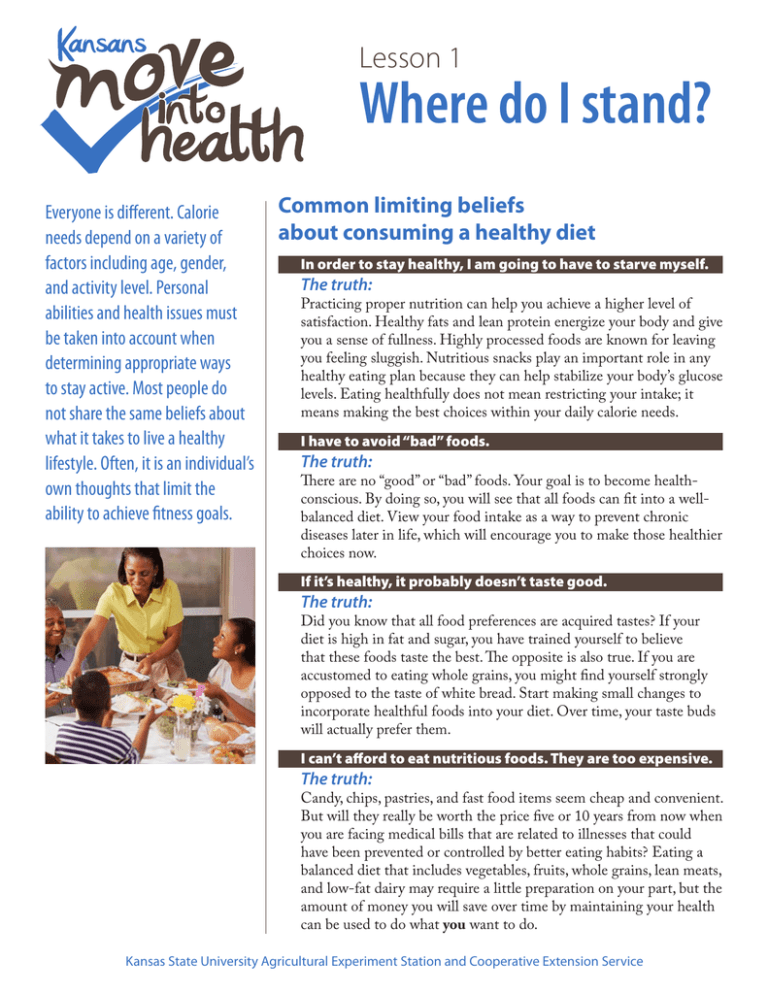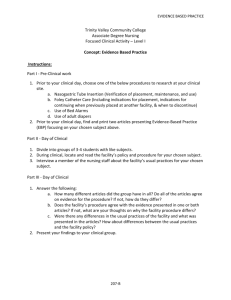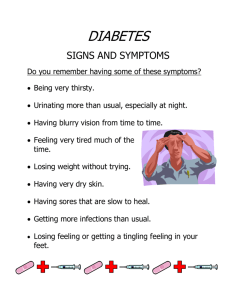Where do I stand? Lesson 1 Common limiting beliefs
advertisement

Lesson 1 Where do I stand? Everyone is different. Calorie needs depend on a variety of factors including age, gender, and activity level. Personal abilities and health issues must be taken into account when determining appropriate ways to stay active. Most people do not share the same beliefs about what it takes to live a healthy lifestyle. Often, it is an individual’s own thoughts that limit the ability to achieve fitness goals. Common limiting beliefs about consuming a healthy diet In order to stay healthy, I am going to have to starve myself. The truth: Practicing proper nutrition can help you achieve a higher level of satisfaction. Healthy fats and lean protein energize your body and give you a sense of fullness. Highly processed foods are known for leaving you feeling sluggish. Nutritious snacks play an important role in any healthy eating plan because they can help stabilize your body’s glucose levels. Eating healthfully does not mean restricting your intake; it means making the best choices within your daily calorie needs. I have to avoid “bad” foods. The truth: There are no “good” or “bad” foods. Your goal is to become healthconscious. By doing so, you will see that all foods can fit into a wellbalanced diet. View your food intake as a way to prevent chronic diseases later in life, which will encourage you to make those healthier choices now. If it’s healthy, it probably doesn’t taste good. The truth: Did you know that all food preferences are acquired tastes? If your diet is high in fat and sugar, you have trained yourself to believe that these foods taste the best. The opposite is also true. If you are accustomed to eating whole grains, you might find yourself strongly opposed to the taste of white bread. Start making small changes to incorporate healthful foods into your diet. Over time, your taste buds will actually prefer them. I can’t afford to eat nutritious foods. They are too expensive. The truth: Candy, chips, pastries, and fast food items seem cheap and convenient. But will they really be worth the price five or 10 years from now when you are facing medical bills that are related to illnesses that could have been prevented or controlled by better eating habits? Eating a balanced diet that includes vegetables, fruits, whole grains, lean meats, and low-fat dairy may require a little preparation on your part, but the amount of money you will save over time by maintaining your health can be used to do what you want to do. Kansas State University Agricultural Experiment Station and Cooperative Extension Service My beliefs about consuming a healthy diet My nutrition mission statement” Common limiting beliefs about physical activity I can’t exercise because I don’t belong to a gym or health club. The truth: There are lots of ways to stay active outside the confines of a traditional exercise facility. Check out local trails and bike paths in your neighborhood. Purchase a few workout DVDs and some hand weights for home use. Even better, check out the video selections at your local library and practice lifting household objects. Be creative! Anything goes, as long as you’re moving. The only way to get results is to spend hours working out. The truth: Studies have shown similar health benefits in those who split up their workouts. Squeeze in three 10-minute sessions instead of logging 30 minutes straight. This strategy is ideal for the busy individual. Take the stairs instead of the elevator, walk the dog, or get in on an active game with the neighborhood kids. Small changes make a big difference. I have never been athletic. Being physically active is too hard. The truth: Physical activity is not limited to athletes. If you lead an inactive lifestyle, movement may seem challenging at first. Results don’t appear overnight, so don’t let that discourage you. Staying physically active gets easier the more you do it. Instead of focusing on the big picture, consciously make small changes daily. Over time, you will see the benefits of your efforts. Exercise is boring. I can’t ever commit myself to a routine. The truth: The best part about staying active? There is nothing routine about it! Throw all the so-called “rules” out the window and mix it up. Swim some laps in the neighborhood swimming pool. Sign up for a ballroom dance class. Jump rope with the kids. Expose yourself to a variety of activities to keep your heart pumping and your enthusiasm high. My beliefs about physical activity My physical activity mission statement” This week's Move into Health action plan Three-Day Food/Activity Log Please record your food intake and physical activity for three days. Try to include a weekend day in your selections. Day 1 Check One: Weekday What did I eat or drink and how much? Weekend Day Where did I have this? Notes (hunger, emotions, other) Today’s food intake was: More than usual Less than usual About usual. Kind of physical activity Minutes spent at activity Intensity (moderate or vigorous) Today’s physical activity was: More than usual Less than usual About usual Day 2 Check One: Weekday What did I eat or drink and how much? Weekend Day Where did I have this? Notes (hunger, emotions, other) Today’s food intake was: More than usual Less than usual About usual. Kind of physical activity Minutes spent at activity Intensity (moderate or vigorous) Today’s physical activity was: More than usual Less than usual About usual Day 3 Check One: Weekday What did I eat or drink and how much? Weekend Day Where did I have this? Notes (hunger, emotions, other) Today’s food intake was: More than usual Less than usual About usual. Kind of physical activity Minutes spent at activity Intensity (moderate or vigorous) Today’s physical activity was: More than usual Less than usual About usual Lesson 1 Supplement Examples of moderate physical activities • Walking briskly (about 3½ miles per hour) • Hiking • Gardening/yard work • Dancing • Golf (walking and carrying clubs) • Bicycling (less than 10 miles per hour) • Weight training (general light workout) Examples of vigorous physical activities • Running/jogging (5 miles per hour) • Bicycling (more than 10 miles per hour) • Swimming (freestyle laps) • Aerobics • Walking very fast (4½ miles per hour) • Heavy gardening/yard work (chopping wood, digging, hoeing, etc.) • Weight lifting (vigorous effort) • Basketball (competitive) Source: www.mypyramid.gov How to change a limiting belief 1. Write down the old belief and the new belief side by side. 2. Under the old belief, write down all the behaviors and results that the belief creates. 3. For each result, write down how that result makes you feel. 4. Under the new belief, write down all the behavior results that you think the belief would create. 5. For each result, write down how that result makes you feel. Brand names appearing in this publication are for product identification purposes only. No endorsement is intended, nor is criticism implied of similar products not mentioned. Publications from Kansas State University are available at: www.ksre.ksu.edu Publications are reviewed or revised annually by appropriate faculty to reflect current research and practice. Date shown is that of publication or last revision. Contents of this publication may be freely reproduced for educational purposes. All other rights reserved. In each case, credit Tandalayo Kidd, Ph.D., R.D., L.P.N., Assistant Professor/Nutrition Specialist, Department of Human Nutrition, and Katie Hamm, Senior in Dietetics, Move Into Health: Where Do I Stand, Kansas State University, July 2011. Kansas State University Agricultural Experiment Station and Cooperative Extension Service MF2958 July 2011 K-State Research and Extension is an equal opportunity provider and employer. Issued in furtherance of Cooperative Extension Work, Acts of May 8 and June 30, 1914, as amended. Kansas State University, County Extension Councils, Extension Districts, and United States Department of Agriculture Cooperating, Gary Pierzynski, Interim Director.


